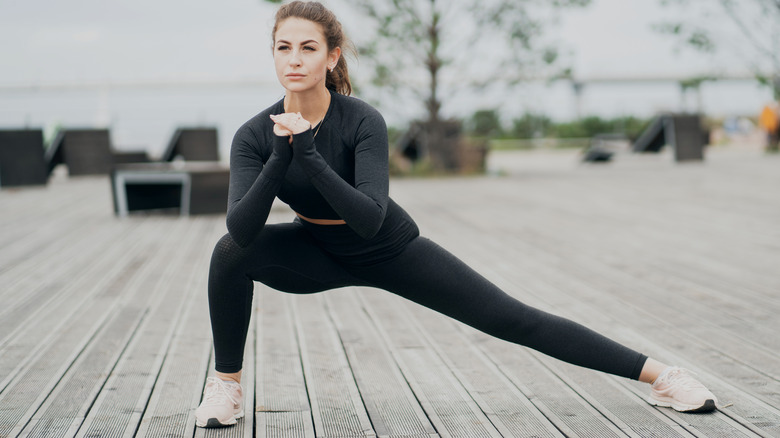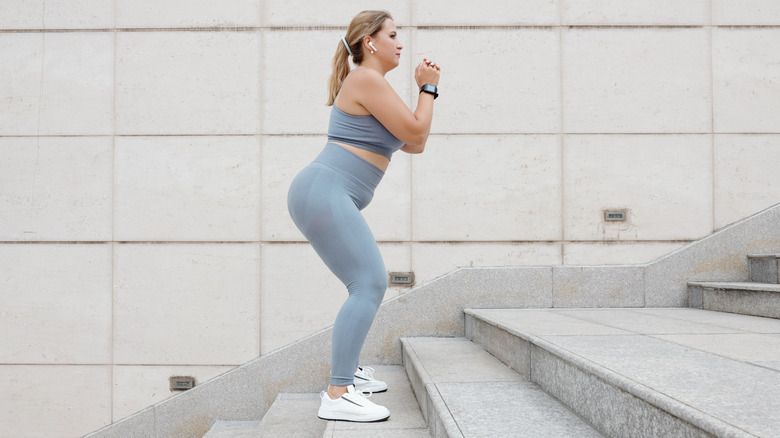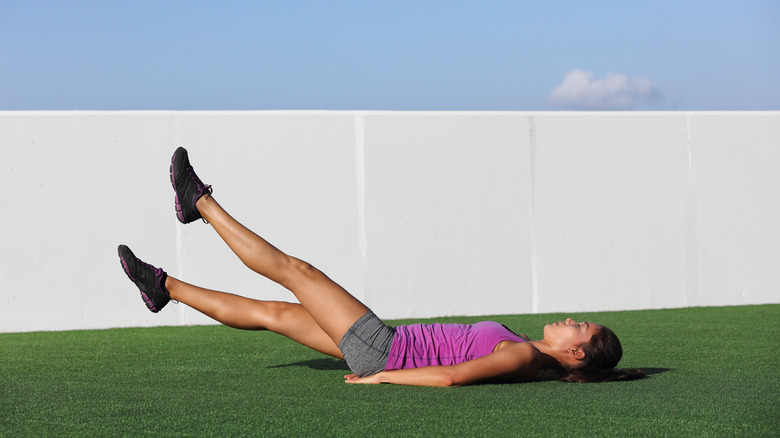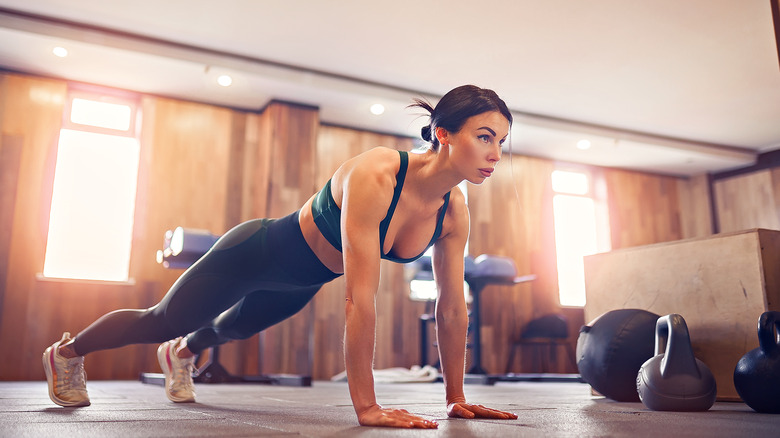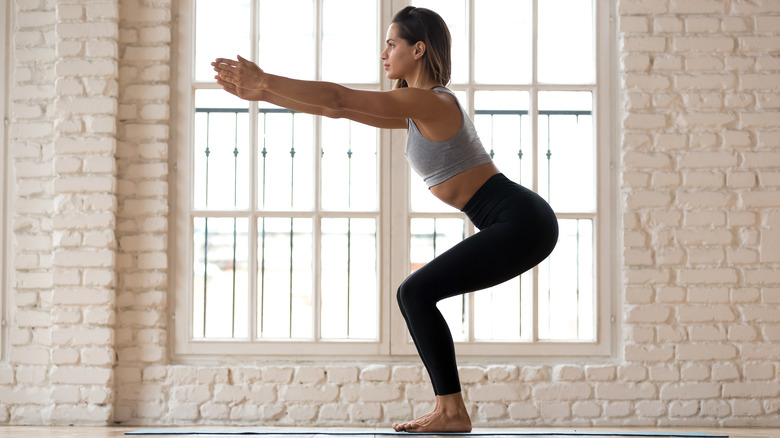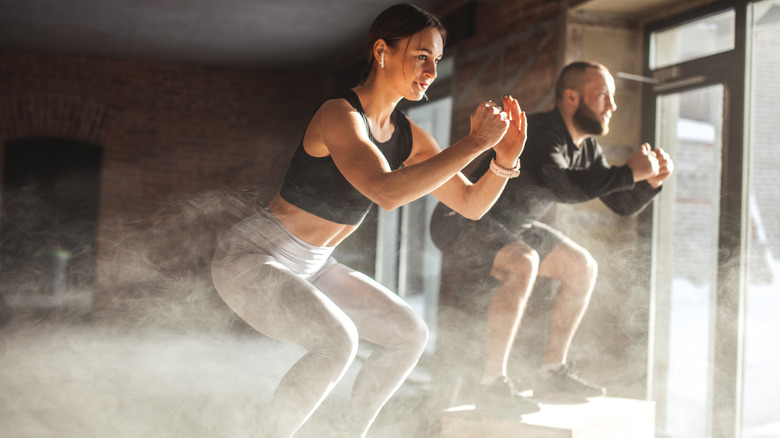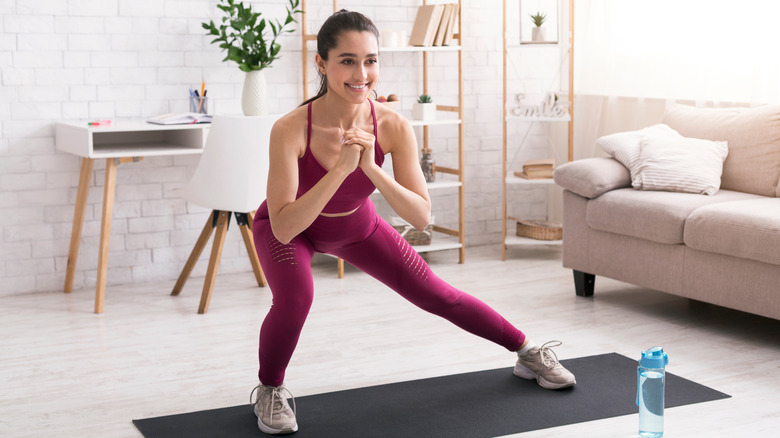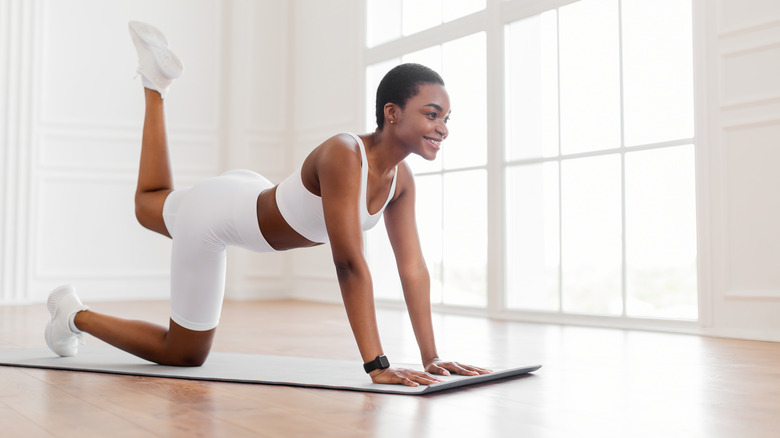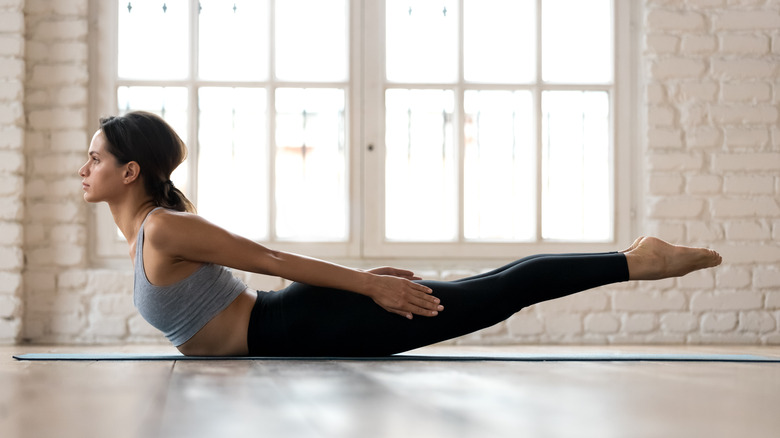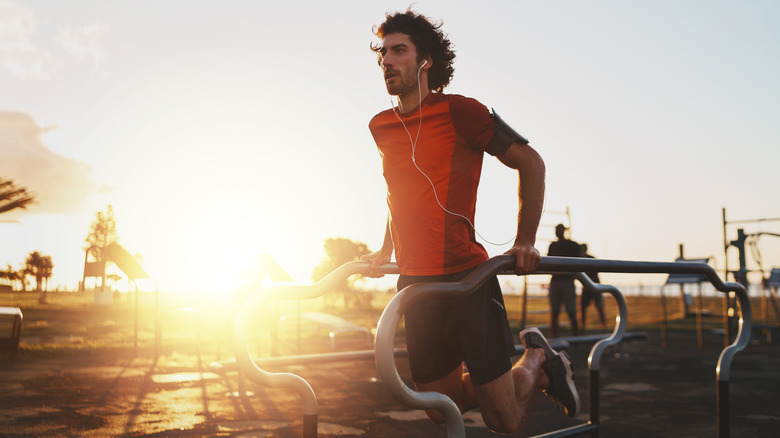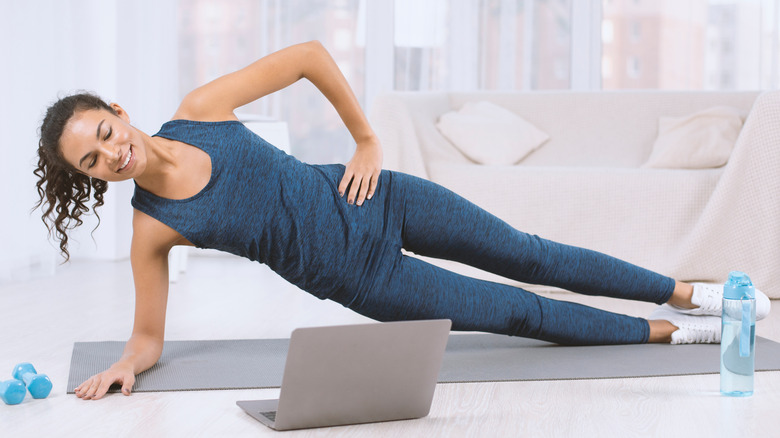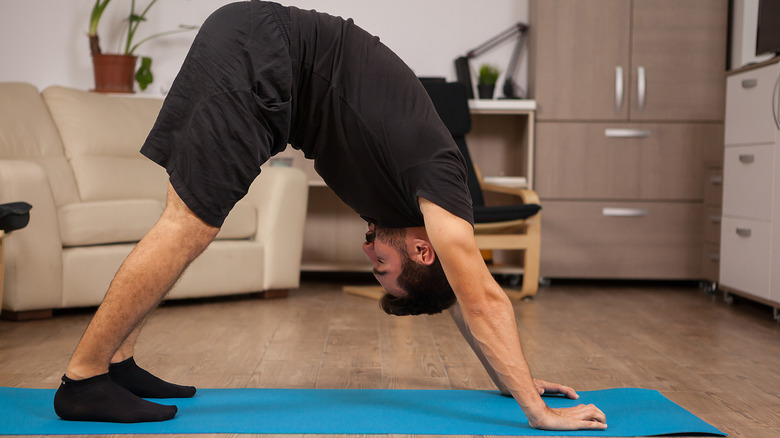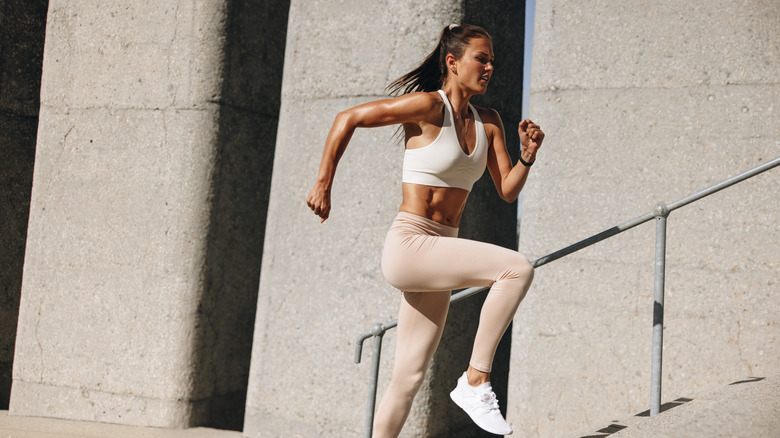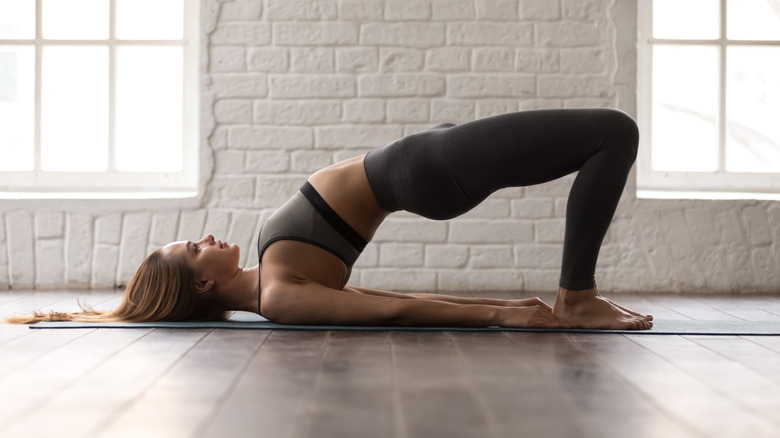The Best Workouts For People Who Hate Lifting Weights
If you are someone who considers driving circles around the gym to be the closest you'll get to a workout, we have some good news for you: There are plenty of ways to work out, and many of them do not even involve stepping into the gym or lifting a single weight.
Using your own body weight to work out is both a free and convenient way to target certain areas of your body that you want to strengthen and tone. Furthermore, a 2016 study published in the Journal of Human Kinetics confirmed that bodyweight workouts have been shown to increase agility and improve athletic performance.
You don't need to be an athlete to reap the benefits from these exercises, either. Whether you consider yourself to be someone who is simply averse to lifting weights or are just looking for a simple way to get in shape at home, read on to discover the best weight-free workouts to get the job done.
Squat jumps
Squat jumps are a plyometric exercise, which is a type of high-impact exercise that requires the muscles to work in short bursts (via Women's Health). According to a 2016 study published in The Journal of Sports Science and Medicine, squat jumps can be used to help develop "explosive strength," decrease sprint time, and improve overall athletic performance.
Squat jumps target the lower body from the calves to the glutes and also work the core. The difference between squat jumps and the traditional squat is — you guessed it — the jump. Whereas a traditional squat would have you rising slowly to a standing position to finish, squat jumps require a quick burst of energy at the end with a jump, increasing your heart rate and helping you to burn more calories.
According to Women's Health, the best way to perform a squat jump is to begin with your feet shoulder-width apart and pointing outwards. Bend your knees into a squat while maintaining a straight back and open chest. After squatting as far down as you can, squeeze your glutes, jump upwards quickly with your arms raised to the ceiling, and return to the squat position. Repeat. If you are looking to incorporate cardio and high-intensity interval training into one solid move — no weights required — squat jumps could be your new go-to workout.
Flutter kicks
If you want to strengthen and tone your core, look no further. According to NASM-certified trainer Bree Branker, flutter kicks engage several different core muscles at the same time. "It has a huge bang for your buck in the core area. The stronger the core, the more functional you move as a human," Branker told Women's Health. According to Branker, a strong core provides a solid base for all other workouts, and flutter kicks are a great way to strengthen this area.
To begin this exercise, start by laying on your mat. You can grab a medicine ball (or a dumbbell if you don't mind some traditional weights) and raise your arms to hold it over your head. Raise your head and upper back off the mat while lifting your legs upwards at a 45-degree angle. Point your toes and move your legs up and down in a scissor-like motion while keeping your core muscles engaged.
When you are finished with your reps, gently return your upper back and legs to rest on the mat. Branker suggests starting by timing yourself for 30 seconds and aiming for at least three or four rounds of the exercise.
Calf raises
No more excuses to skip leg day with this easy workout in your bag of tricks. Calf raises focus on strengthening the calf muscles, which support us in jumping, running, walking, and a variety of other activities that we often take for granted. The calf is composed of two muscles — the gastrocnemius, which is the larger part of the calf muscle that you can see — and the soleus, which is the smaller of the two muscles, and is located underneath the gastrocnemius.
According to the American Council on Exercise (ACE), calf raises are best done in front of a wall. To begin the exercise, experts at the council suggest standing approximately 6 inches to a foot away from the wall. Face the wall, spread your feet hip-width apart, stretch your arms outward, and place your hands on the wall. While keeping your toes on the ground, raise your heels upwards while engaging your calf muscles. Stay raised for a moment before lowering your heels to the ground. Do as many reps as you can.
ACE also suggests gradually increasing the force you use to propel yourself upwards for ongoing strengthening as you continue to strengthen your calf muscles with this exercise.
Burpees
Burpees are one of the most well-known body-weight exercises and are a staple in many people's fitness routines for good reason. Burpees are a powerhouse exercise that work the entire body and provide the winning combination of cardio and strength training resulting in overall improved fitness.
According to a 2016 study published in Plos One, doing a total of 30 minutes of a high-intensity training exercise like burpees per week can be equally as effective as doing 150 minutes of moderate-intensity training. As ACE-certified trainer and strength and conditioning coach Brandon Mentore explained in an article for Women's Health, burpees may not be famous for how enjoyable they are, but they pay off with a long list of benefits that even include improving your fight or flight reaction time.
Make sure you are using the right form with this exercise, as burpees can cause considerable injury if done the wrong way. To begin this exercise start by standing up and spreading your feet shoulder-width apart. Squat your body as low to the floor as you can, place your hands on the ground, and explode your legs back into a plank position. Quickly bring your legs forward, landing both feet outside of your hands, and quickly stand back up. As for how many to do, Mentore suggests 10 to 15 repetitions if you are doing multiple sets. However, if you are sticking to just one set you can do as many as you want.
Chair pose
If this is your first time hearing of the chair pose you might be wondering how a tool often used to avoid working out could help improve your fitness goals. Alas, there is no actual chair involved in this particular workout — and there are actually a surprising number of benefits. Traditionally used in yoga, the chair pose works a number of muscle groups including the core, lower body, and upper body all at the same time.
According to a study published in the International Journal of Environmental Research and Public Health in 2021 that evaluated the benefits of five yoga poses, the chair pose presented the highest activation of the quad muscles out of all five. The study also showed that in addition to improving overall exercise ability, the chair pose is great for toning the legs, and can even improve the condition of flat feet as it stretches the calves and helps to lift the inner arches. Chair pose can be particularly good for those with existing knee conditions, as it can help to strengthen the knees considerably.
To do this pose start by standing with your feet hip-width apart. Bend down halfway, pushing your bottom outward, and raise your arms upwards, palms facing inwards, and keep them shoulder-width apart. Hold the pose for as long as you can while engaging your core, then slowly raise your body to a standing position.
Tuck jumps
Tuck jumps are a great plyometric exercise that provide a range of benefits including a great cardiovascular workout and strength training at the same time. They work the entire body and require a lot of force that can help you burn significant calories.
As Laurence Marie, trainer at F45 Noak Hill, explained to Women's Health, "As you drop down into the quarter squat think of your hamstrings as a loaded spring. When you shoot up again your quadriceps and glutes will fire up and the loaded energy will be released with the additional upward force generated by your calves." Like the other plyometric exercises, tuck jumps are favored by athletes for their ability to increase performance and power, particularly in the lower body.
According to a 2019 study published in Athletic Therapy Today, you should begin this exercise with your feet shoulder-width apart. Bending down only slightly, reach your arms behind you and then swing them forward as you launch yourself upwards and pull your knees up at the same time. Your thighs should remain parallel to the ground during this exercise. After you land, begin the next jump, and repeat as many times as you can.
Clock lunge
The clock lunge is a great workout for those looking to strengthen the lower body and it engages your glutes, hamstrings, quads, calves, and even a few core muscles. What makes the clock lunge different from a traditional lunge is that with this exercise you are extending your legs both forwards and to either side, which works the quads and the inner and outer thighs. According to the National Strength and Conditioning Association, lunges are great workouts for improving balance, posture, core strength, and can even help reduce lower back pain. With clock lunges the core must be engaged to stabilize the body while it is in a "staggered stance," which is what can lead to improved balance.
To do this exercise start by standing with legs hip-width apart, hands on your hips. Drop down and lunge forward with your left foot, bending down to form a 90-degree angle with your knee. Release the pose and stand up.Next, drop down, extend your right leg to your right side, and form a 90-degree angle while keeping your left leg straight. This is the "three-o-clock" position. Return to standing.
After this is the reverse lunge (6 o'clock), where you will step back, lowering yourself down with both knees at 90 degrees. Come back up to a standing position. To complete the clockwise motions you will end with the 9 o'clock lunge, and extend your left leg, bending again at 90 degrees, then coming back to standing after the pose is complete. You are now back at 12 o'clock and can lead this time with the left side to balance out the workout.
Donkey kick
For those who are looking to round out their rear end, the donkey kick is the perfect exercise to add to your workout routine. Specifically targeting the glutes, this exercise requires you to get on all fours with your shins on the ground and your palms pressing into the floor. With a flat back and neck, start by kicking your left leg upwards while maintaining the bend in the leg. Be sure to keep your back flat through the duration of the pose. Lower your leg to the ground and repeat on your left side for as many reps as you can before moving onto the right.
As Keaton Ray, certified strength and conditioning specialist, trainer, and co-founder of MovementX told Women's Health, "It helps stretch the hip in the opposite direction that we hold it when we sit. Both of these things will help to improve posture and prevent hip and spine injuries."
Superman
While this exercise may appear to be easy or perhaps even effortless at first glance, the superman requires you to engage almost all of the body's muscles in one fell swoop. Peloton Instructor Tunde Oyeneyin told Good Housekeeping that the superman is a functional move that engages numerous muscles including the lower back, oblique, and core. She shared that the pose can lead to improved posture by "strengthening muscles in the back can help improve your mobility, potentially lowering the risk of injury and improving overall posture."
To do this exercise, Oyeneyin advises beginning with lying on your mat face down with your arms stretched out in front of you. Using the strength of your core muscles, raise your arms and your legs slightly off the mat, keeping them in position while fully engaging your core. Hold the pose for as long as you can, then lower your extremities back onto the mat. Repeat as many times as you like.
She also suggests adding variations of the pose if you want to mix up your routine, which can include moving your legs and arms up and down in a scissor-like motion (similar to flutter kicks) for what she calls the "alternating superman."
Tricep dips
If you are looking to strengthen your arms and your upper body without lifting weights, add tricep dips to your growing list of favorite workouts. Body-transformation coach, Charlie Johnson told Men's Health, "Dips are an excellent movement to build size, strength and power into the triceps. [Having] some variation of dips within a training [program] is a wise idea if you're looking to develop this muscle group and improve your pressing strength."
Johnson explained that tricep dips require you to have parallel bars (which can be found at gyms), gymnastic rings, or even two chairs (just make sure they are sturdy) to execute. Once you have found your base, grab onto whatever you are holding with your arms straightened and by your side. Keeping your arms close to your torso, bend your knees, raise your legs, and cross your ankles. Dip yourself down until your elbows are at 90 degrees without touching the ground. Raise yourself up with your arms, and repeat.
Some of the common mistakes Johnson says people make with this exercise are leaning too far forward, dipping down too low to the floor, locking the elbows, and scrunching up your shoulders. Be sure to avoid these rookie mistakes to get the best out of this workout.
Side plank
The side plank is another great workout borrowed from yoga that targets and strengthens the oblique muscles. According to a 2019 study published in the International Journal of Environmental Research and Public Health, the side plank is the perfect workout to help stabilize the quadratus lumborum, which are the muscles on either side of the spine in the lower back, and are most commonly associated with lower back pain. Furthermore, the study explained that the nature of the pose minimizes stress placed on the lower back, increasing its benefits for those who have back pain.
To execute this workout, begin in a regular plank position. Rotate to the side (facing your right) and rest your weight on your right forearm while you stack your feet side by side, resting them on the knife edge of your right foot. Make sure that your hips are lifted off the mat, and maintain this posture for at least 15 seconds or as long as you can handle it. When finished, repeat the exercise on the left side (via Healthline).
Dolphin pushups
Playful name aside, dolphin pushups require some serious strength and are therefore best for those who have already worked on strengthening their cores. Trainer Katie Fogelson told Well+Good, "A dolphin push-up is essentially a dynamic forearm plank. By adding the push-up you further challenge the shoulders, specifically the muscles surrounding the shoulder blades, and place more demand on the core, in general, to stabilize the spine as the hips move in and out of a pike."
To do this pose, start in a traditional plank position. Place your forearms on the floor with your palms pressed into the ground. Use your core strength to push your hips and glutes to the ceiling so you are in an upside-down "V" position, then lower back down into a regular plank. Repeat as many times as you can. Fogelson further explained that this move "can be a great introduction to inverting, especially those new to being upside down or wanting to build strength for more advanced inversions like forearm stands."
Step-ups
As fitness expert Dr. Laskowsk told the Mayo Clinic, step-ups are a straightforward exercise that zeroes in on the lower body, specifically the quads, glutes, calves, and hamstrings. Because this is a relatively easy and low-impact exercise, it is a great starting point for someone who is just beginning to exercise, or for someone with limited mobility. Furthermore, it can also serve as an alternative to squats for those who experience lower back pain. Since step-ups are unilateral — meaning they work one side of the body at a time — they are a good exercise to help you achieve balance.
This exercise requires a step stool or a set of stairs. Step onto the stool or stair with your entire right foot, pushing down, and then lower yourself back to the ground. Repeat this exercise on the left side, and continue rotating your legs making sure your core is engaged throughout the process.
Shoulder bridge
This pose makes regular appearances in many pilates workouts and works the legs, glutes, as well as the core and lower back. It's another exercise that may look easy to the untrained eye, but it engages many muscle groups at the same time making for a powerful workout.
A 2018 study published in The Journal of Physical Therapy Science showed that bridge exercises can significantly strengthen and bulk the "deep abdominal muscles," which are key in supporting the stability of the lower back. Furthermore, the study revealed that the pose "increased the endurance and flexibility of the waist muscles in the case of teenagers with lumbar pain."
To properly execute the shoulder bridge, lie on your back, feet on the floor, with your knees bent upwards. Keep your arms on the ground with your palms pressed into the floor, and use your core strength to lift your hips into the air. Keep your glutes and core engaged as you hold the posture for at least 30 seconds. Return to the ground, and repeat as many times as you can.

